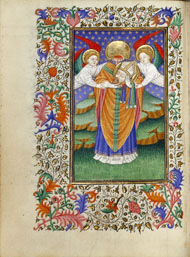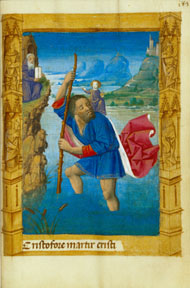|
From the fall of the Roman Empire in about 476 until the advent of the Lutheran Reformation in 1517, the "cult of saints" was one of the central forms of religious expression in Western Europe.
Saints were petitioned for aid in times of need and provided models of pious behavior. The faithful sought contact with the bodily remains of saints (relics) in the hopes of miraculous cures, built churches in their names, and fashioned their images in sculpture and painting. This exhibition explores this important phenomenon, focusing on manuscripts in the Getty Museum's collection that contain devotional images of saints and illustrations from their lives. Saint Anthony, seen above, led a solitary, ascetic life in the late 200s. In the late 1100s he became known as a protector of both animals and humans from disease. Here St. Anthony is depicted with his followers, who are gathered at his feet.
|
 |
|
Medieval Christians believed the saints resided with God in heaven but were listening to the prayers of the faithful on earth who asked for their aid and intercession. Within the heavenly ranks there was both a hierarchy and a categorization of saints. The apostles and John the Baptist were first in rank. Then came a number of postbiblical types: martyrs (those who died for their faith), confessors, and virgins.
The virgin saints depicted here hold prayer books in their laps as they sit humbly on the ground with flowing golden locks and creamy complexions that enhance their desirability. The battle against desires of the flesh was an important theme in many saints' lives, but it was especially significant among female saints.
|
 |
|
One of the criteria for being a saint was being able to work miracles. Often this came in the form of healing the sick or saving people in trouble. Sometimes these miracles included visionary experiences.
Medieval believers understood that saints often received divine interventions through works of art that came to life. This miniature depicts a vision that Saint Bernard of Clairvaux (1090–1153) experienced before a statue of the Virgin. While reciting a prayer to the Virgin Mary, the Ave Maris Stella (Hail, Star of the Sea), he uttered the phrase written above the Virgin's head: Monstra te esse matrem (Show yourself to be a mother). The statue came to life, and drops of milk, representing the gift of life, fell from the Virgin's breast onto his lips.
|
 |

 |
 |
Saint Denis Holding His Head, Attributed to the Master of Sir John Fastolf, about 1430–1440
|
 |
 |
|
|
 |
Death was fundamental to the cult of saints. Not only did saints answer prayers from their position in heaven, but their human remains still existed on earth. Known as relics, these remains of a saint's body (such as a finger or a jawbone) were believed to represent the whole saint. Enshrined in gold, relics were thought to have miraculous powers, making the graves of saints the focus of pilgrimage.
In this image, we see Saint Denis, the first bishop of Paris who was beheaded around the year 250. Accompanied by angels, he carries his own head to his burial site where the church of St. Denis was later built. The artist gave the saint two halos, one behind his decapitated head and another behind the stump of his neck, emphasizing the Saint's full presence in each part of his body and the incorruptibility of his physical remains.
|
 |
|
Saints were also important as models of piety whose behavior could be imitated. Various religious orders were founded by men or women who became such role models. Here we see Saint Bernward, the founder of the Abbey of Saint Michael at Hildesheim and a role model for his monastic community. The monks who lived at Saint Michael's generations after his death, when this manuscript was made, are shown at Bernward's feet and in the frame around him.
The illumination depicts Saint Bernward as protector of the monks of his monastery. Above, an angel gives the saint a cross. The Latin text on the scroll over his arm reads, "No danger endures before this sign." The kneeling monk who touches Bernward's feet, pleads, "Remember your congregation."
|
 |

 |
 |
Saint Christopher Carrying the Christ Child, Master of Guillaume Lambert, 1478
|
 |
 |
|
|
 |
In the late Middle Ages (about 1300–1550) the book of hours was the most popular type of devotional book. A section in these books contained short prayers to the saints. Saints included were often the saintly patrons of the book's owner.
Saint Christopher, an enormously popular saint, is depicted in this book of hours. According to legend, he was assigned the task of helping travelers cross a river. One day, a child asked to be ferried. Christopher had difficulty because of the boy's extraordinary weight. The child then told him that he was carrying the weight of the world on his shoulders. It was Jesus who rode upon his back. Thus, Christopher became the patron saint of travelers.
The exhibition is located at the Getty Center, Museum, North Pavilion.
|
 |